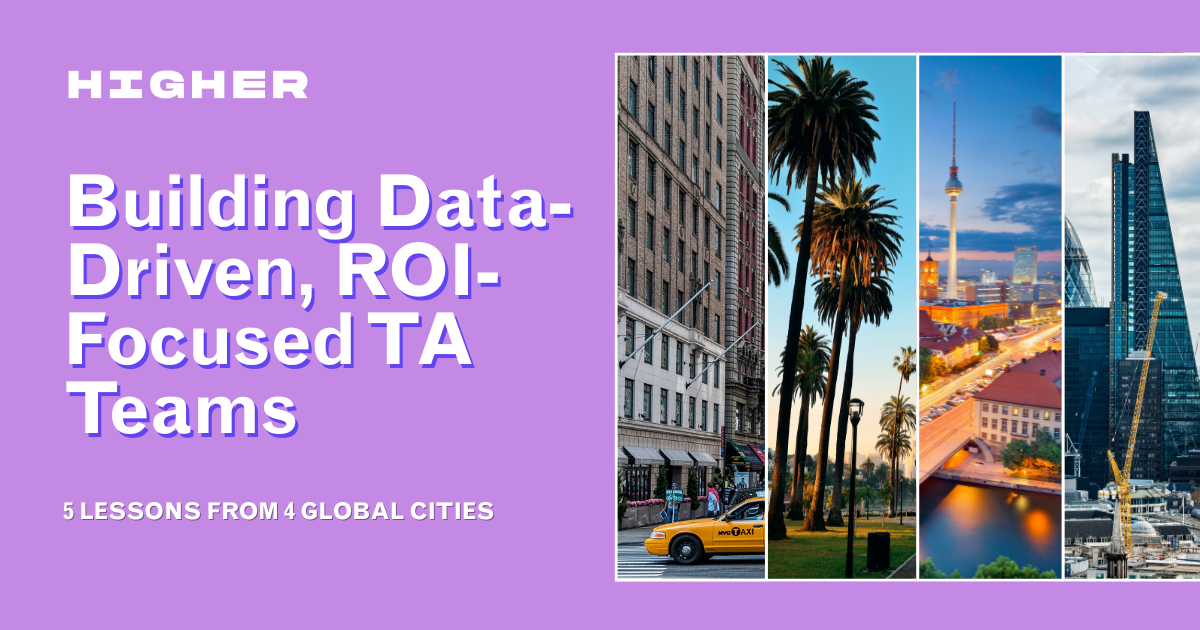Building Data-Driven, ROI-Focused TA Teams: 5 Lessons from 4 Global Cities
Talent leaders everywhere are asking the same question:
How do we evolve hiring strategies for a world where every decision must prove ROI?
This summer, HIGHER hosted exclusive events in Berlin, London, San Francisco, and New York to explore that question. We brought together senior TA and HR leaders to discuss the future of hiring—covering AI adoption, accountability, and what it really takes to build a data-first culture.
We ran a poll across these sessions, and the results were eye-opening:
✅ 48% of the biggest challenges in proving TA ROI relate to data issues—from accuracy gaps to inconsistent reporting and unclear metrics.
Here are the key lessons every TA leader should know.
1. The Business Case for Data-Driven Hiring is Non-Negotiable
Executives now expect more than time-to-fill and cost-per-hire. These metrics still matter—but only as efficiency indicators, not as proof of impact. The conversation has shifted to metrics that speak the language of the business:
Cost of Vacancy: What’s the financial impact of every day a critical role stays open?
Headcount as % of Revenue: How does talent strategy connect directly to top-line performance?
Quality of Hire: Beyond speed—are we hiring for retention, performance, and cultural fit?
And here’s the challenge:
Nearly one in four TA leaders (24%) said defining QoH and ROI metrics is their biggest barrier. Without clear, credible measures, we can’t tell the story that matters most—the business story.
The shift is clear: TA has to move from reporting activity to demonstrating impact that resonates with CFOs and boards.
2. AI is a Force Multiplier, But Only with Good Data
AI was a major focus across all four cities, but adoption varies by region:
San Francisco: Piloting AI in capacity planning, sourcing automation, and predictive headcount modeling.
New York: Leveraging AI for scheduling, reporting, and agile workforce planning.
Berlin & London: Moving cautiously, prioritizing compliance and bias prevention before scaling.
Across the board, one principle holds true: AI amplifies the quality of the data it’s fed. Without strong governance, automation can accelerate bad decisions. And according to our poll:
29% cited data accuracy gaps as a top challenge, and another 14% flagged inconsistent reporting.
Lesson: Before implementing advanced technology, TA leaders need to ensure their data is clean, consistent, and well-governed.
3. Hiring Accountability is a Shared Responsibility
Every discussion highlighted the need for shared responsibility in hiring outcomes. Quality of hire cannot rest with TA alone. Leading organizations are implementing:
SLAs for hiring managers, linking response times to prioritization.
Interview calibration and scoring, evaluating panels on predictive accuracy.
Post-hire reviews, connecting hiring decisions to long-term performance.
When data is unreliable, accountability becomes harder to enforce. You can’t hold people responsible for outcomes they can’t see or trust.
4. Candidate Experience is a Business Metric
Candidate experience is a business lever. Leaders are tracking:
Candidate NPS and onboarding surveys as leading indicators of performance.
The cost of poor experience, including rehire expenses and brand impact.
ROI of process improvements, particularly in executive search and onboarding.
The evidence is clear: a better candidate experience drives retention, enhances brand reputation, and supports revenue goals.
5. Regional Priorities Point to the Same Destination
Every city shared the same goal: make TA a strategic business partner.
The starting points differ:
| City | Top Priority | Biggest Shift |
|---|---|---|
| Berlin | Data governance & hygiene | Aligning TA metrics with business objectives |
| London | KPI standardization, stakeholder alignment | Data storytelling for business impact |
| San Francisco | Revenue-linked TA strategy, predictive analytics | Leading AI pilots, cost of vacancy modeling |
| New York | Candidate experience ROI, flex models | SLAs and formal accountability frameworks |
The takeaway: whether you’re building foundational data practices or piloting advanced analytics, the direction is the same: align TA with business outcomes and embed shared accountability across stakeholders.
Your Action Plan for 2025
✅ Audit your data quality before scaling automation or analytics.
✅ Move from activity reporting to business storytelling—cost of vacancy, revenue impact, quality of hire.
✅ Pilot AI responsibly, ensuring compliance and bias safeguards are in place.
✅ Make candidate experience measurable and link it to retention and brand value.
✅ Build shared accountability through SLAs, interview calibration, and post-hire reviews.
Want to Be Part of These Conversations?
The leaders at these events are shaping the future of talent acquisition. You can, too.
Join HIGHER and get:
Exclusive invitations to in-person events across the US and Europe.
A network of senior TA leaders tackling the same challenges you face.
Real-world strategies and insights to put into action immediately.
Join HIGHER and lead the change.


